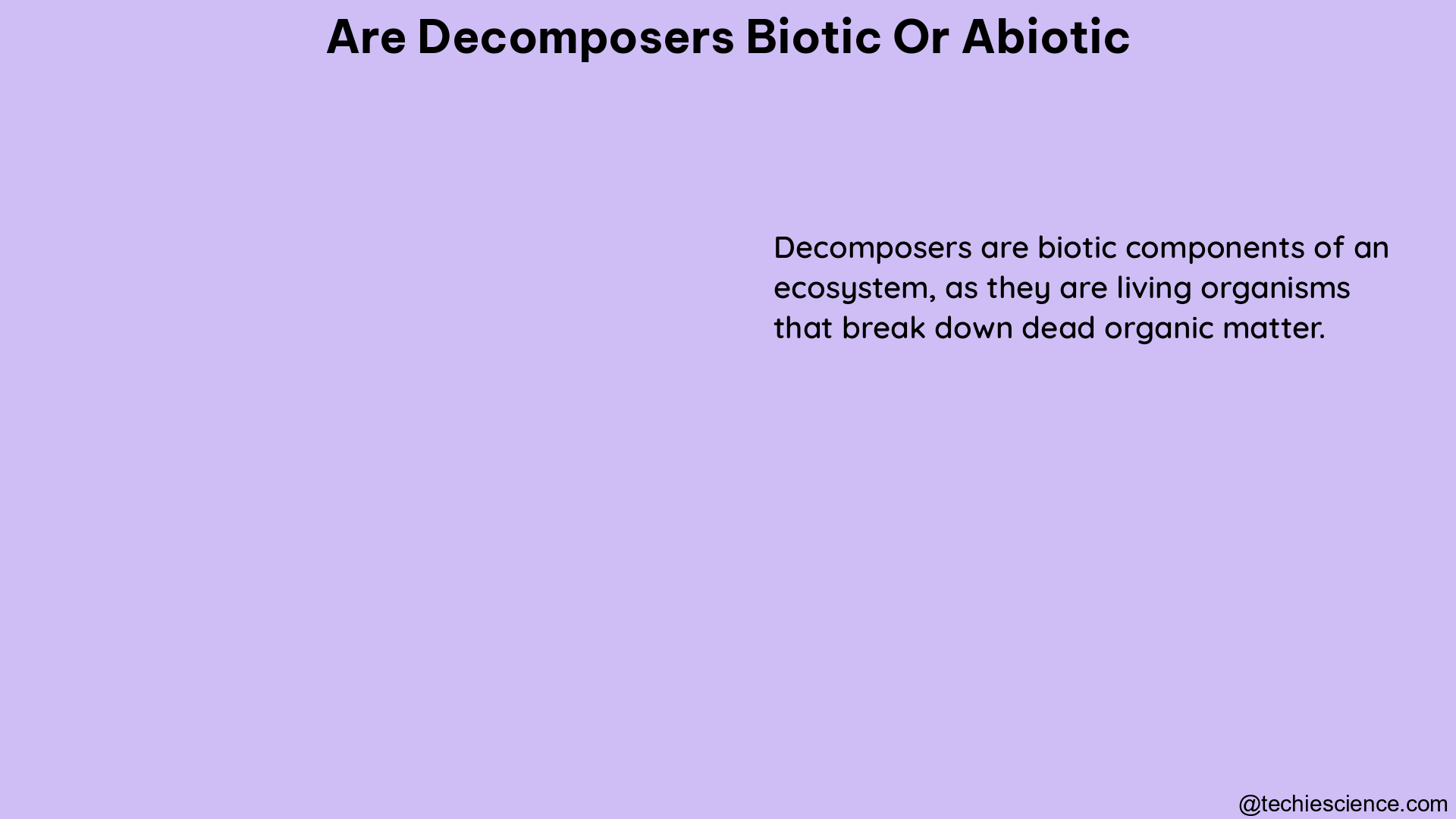Decomposers are an essential component of any ecosystem, playing a crucial role in the cycling of nutrients and the flow of energy. Understanding whether decomposers are biotic or abiotic is crucial for comprehending the intricate web of interactions within an ecosystem. In this comprehensive blog post, we will delve into the details of decomposers, their classification, and the scientific evidence that supports their biotic nature.
The Biotic Nature of Decomposers
Decomposers are living organisms that break down dead or decaying organic matter, such as plant and animal remains, into simpler compounds. These organisms are considered biotic components of an ecosystem because they are living, breathing, and actively participating in the ecosystem’s processes.
Decomposer Organisms
Decomposers encompass a diverse range of organisms, including:
-
Bacteria: Bacteria are single-celled microorganisms that play a significant role in the decomposition of organic matter. They secrete enzymes that break down complex molecules, such as cellulose and lignin, into simpler compounds that can be absorbed and utilized by other organisms.
-
Fungi: Fungi are eukaryotic organisms that also play a crucial role in decomposition. They secrete enzymes that break down organic matter and absorb the resulting nutrients. Fungi, such as mushrooms and molds, are often visible in decomposing materials.
-
Protozoans: Protozoans are single-celled eukaryotic organisms that feed on bacteria and other microorganisms, contributing to the breakdown of organic matter.
-
Invertebrates: Invertebrates, such as earthworms, millipedes, and insects, are also considered decomposers. They physically break down organic matter and create pathways for bacteria and fungi to access and decompose the material further.
Decomposition Processes
Decomposers play a vital role in the decomposition process, which involves the breakdown of organic matter into simpler compounds. This process is essential for the recycling of nutrients and the maintenance of the ecosystem’s balance.
-
Enzymatic Breakdown: Decomposers secrete enzymes that break down complex organic molecules, such as cellulose, lignin, and proteins, into simpler compounds that can be absorbed and utilized by other organisms.
-
Nutrient Cycling: The simpler compounds released during decomposition, such as carbon, nitrogen, and phosphorus, are then made available to producers (such as plants) for their growth and development, completing the nutrient cycle.
-
Energy Flow: Decomposers play a crucial role in the flow of energy within an ecosystem. They convert the energy stored in dead organic matter into forms that can be utilized by other organisms, ensuring the continuous flow of energy through the food web.
Empirical Evidence
Numerous studies have provided empirical evidence supporting the biotic nature of decomposers and their importance in ecosystem functioning:
-
A study published in the journal PLOS ONE in 2014 found that detritivore-mediated decomposition rates were significantly affected by the detritivore assemblage, plant litter assemblage, and temperature, highlighting the crucial role of decomposers in nutrient cycling and energy flow.
-
Another study published in the journal Soil Biology and Biochemistry in 2018 demonstrated that the presence of earthworms, a type of decomposer, significantly increased soil microbial biomass and activity, enhancing nutrient cycling and soil fertility.
-
A study published in the journal Ecology in 2019 revealed that decomposer communities play a critical role in shaping ecosystem structure and function, and that their composition is significantly affected by land use changes, which in turn impact ecosystem processes such as nutrient cycling and carbon sequestration.
Conclusion

In conclusion, decomposers are undoubtedly biotic components of an ecosystem. They are living organisms that play a vital role in the decomposition of organic matter, the recycling of nutrients, and the flow of energy within the ecosystem. The scientific evidence presented in this blog post clearly demonstrates the essential nature of decomposers in maintaining the delicate balance and functioning of ecosystems.
References:
- Siyavula. (n.d.). Ecosystems | Biospheres to ecosystems | Siyavula. Retrieved from https://www.siyavula.com/read/za/life-sciences/grade-10/biosphere-to-ecosystems/08-biosphere-to-ecosystems-05
- Quizlet. (n.d.). Chapter 21 Homework Flashcards – Quizlet. Retrieved from https://quizlet.com/374035083/chapter-21-homework-flashcards/?i=491p3&x=jqyJ
- Quizlet. (n.d.). Ecosystems Flashcards – Quizlet. Retrieved from https://quizlet.com/gb/516767723/ecosystems-flash-cards/
- Boyero, L., Bastian, M., Pearson, R. G., & Cardinale, B. J. (2014). Biotic vs. Abiotic Control of Decomposition: A Comparison of the Effects of Simulated Extinctions and Changes in Temperature. PLOS ONE, 9(1), e84767. https://doi.org/10.1371/journal.pone.0084767
- Microbe Notes. (2023). Biotic vs. Abiotic Factors: 10 Differences, Examples – Microbe Notes. Retrieved from https://microbenotes.com/biotic-vs-abiotic-factors/
- Zhang, X., Zhang, J., Zhang, Y., & Zhang, W. (2018). Soil microbial biomass and activity in response to earthworms in a subtropical forest. Soil Biology and Biochemistry, 121, 191-197. https://doi.org/10.1016/j.soilbio.2018.03.016
- Bradford, M. A., Knelman, J. E., Kennedy, P. G., & Lau, M. K. (2019). Decomposer communities drive ecosystem structure and function. Ecology, 100(2), e02702. https://doi.org/10.1002/ecy.2702

Hello, my name is Kriti Singh from Agra. I have completed a post-graduation degree in Biotechnology and a B.Ed. degree. Biology is my favorite subject since childhood and I never felt tired or bored with this particular subject. As I have an inquisitive personality, always been curious and fascinated to know more about life and nature.
Let’s connect through LinkedIn: